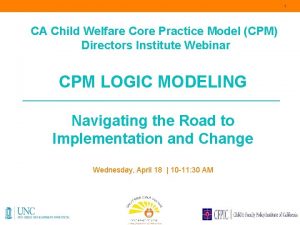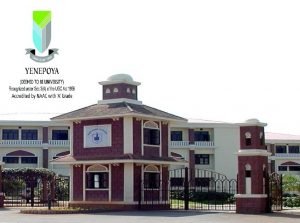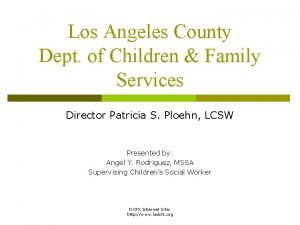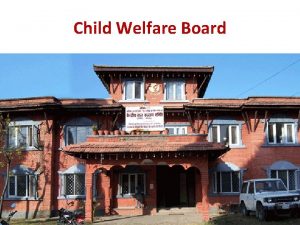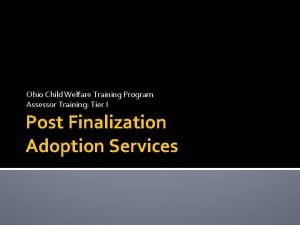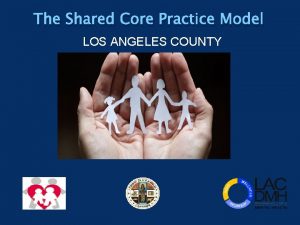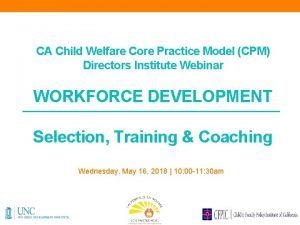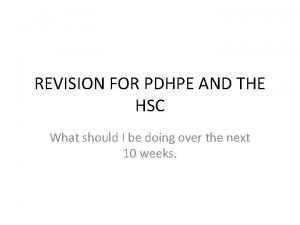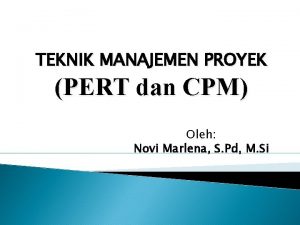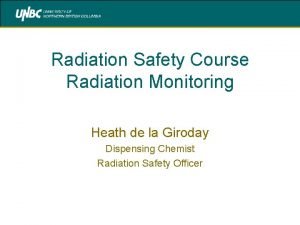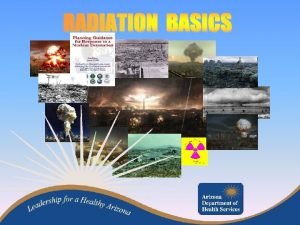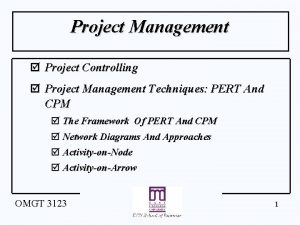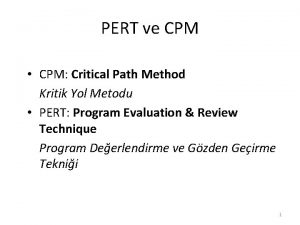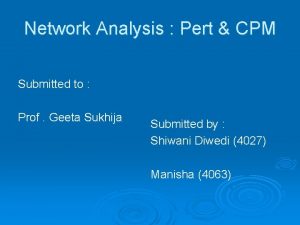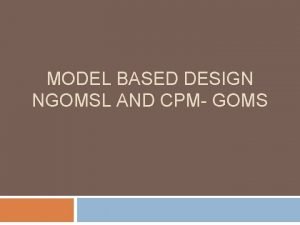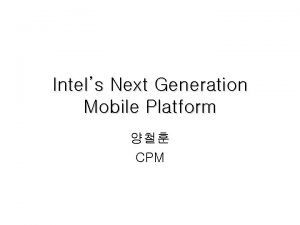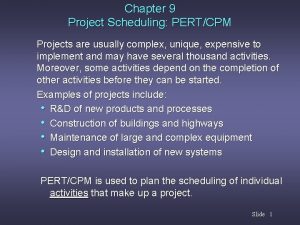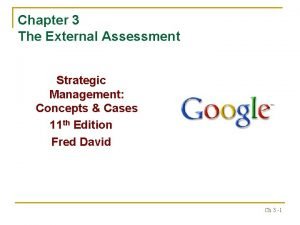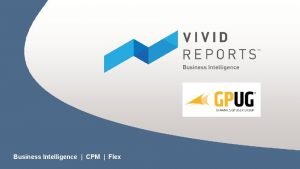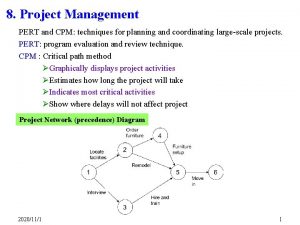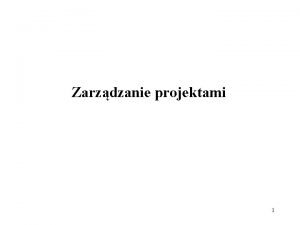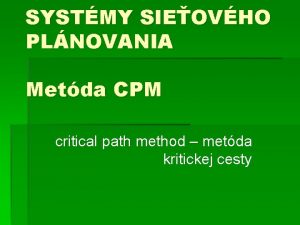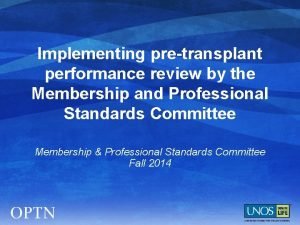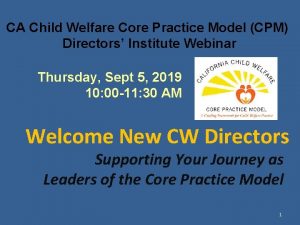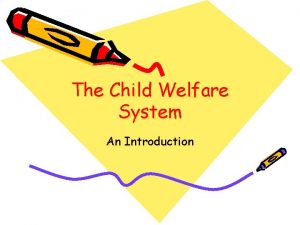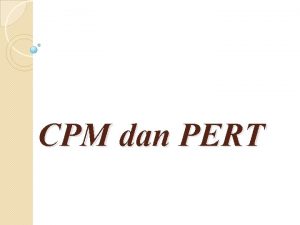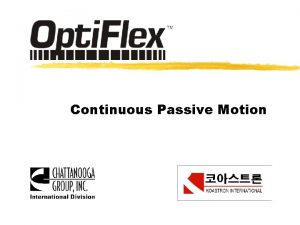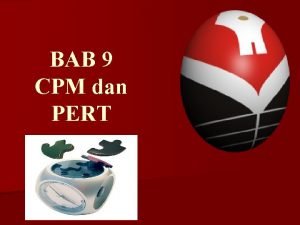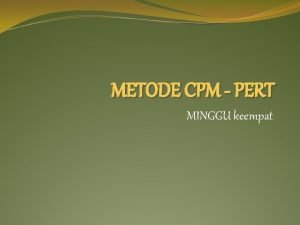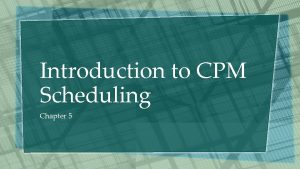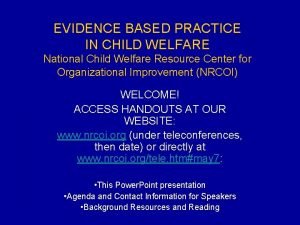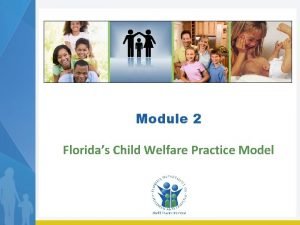1 CA Child Welfare Core Practice Model CPM











































- Slides: 43

1 CA Child Welfare Core Practice Model (CPM) Directors Institute Webinar CPM LOGIC MODELING Navigating the Road to Implementation and Change Wednesday, April 18 | 10 -11: 30 AM

2 When those involved in using or supporting a new practice understand theory behind it and contribute to the plan for change, they are more invested in the work and achieve better outcomes. CPM logic modeling provides tools for engaging staff and partners in CPM change strategies, using data for improvement, and ultimately telling the story of CPM and its impact in the county.

3 Learning Objectives • Learn how the Snapshot and CPM Implementation Tools lead to a practical Logic Model process for your agency • Explore working examples of Logic Models based on simplementation plan data • Engage teams of participants in active Logic Model planning based on Director’s Institute tools, resources, and sample templates

4 CPM Implementation Logic Modeling Sep 2017 Mapping Webinar Apr 2018 Logic Modeling Webinar Nov 2018 Snapshot Webinar builds on content from past webinars CPM Director’s Institute Mar 2018 Org Read Building Webinar Feb 2018 Impl Planning Webinar • Today’s webinar Jan 2018 Messaging Webinar

5 BUILDING BLOCKS Supporting Quality Implementation and Outcomes SNAPSHOT examines current reality, interprets results, identifies planning priorities IMPL PLANNING develops implementation objectives and action steps in priority areas; identifies support resources for success LOGIC MODELING strengthens focus on data & outcomes; creates a concise picture of local implementation efforts to share and encourage others’ interest, investment and support

6 CPM Logic Modeling Navigating the road to implementation and change

7 Logic Model Insights. . . If there was a time when you or your agency were involved in developing or using a logic model… Share what worked about that process. How was the logic model used/helpful?

8 The Many Uses of Logic Models § For evaluation purposes § Communication tool with diverse audiences § Guide project planning and development § Manage a program or project § Guide local implementation effort § And more…

9 CPM Implementation Logic Models… • Build on priorities in local implementation plan • Show the agency is making changes to support and reinforce CPM • Point everyone toward the implementation outcomes they are collectively working to achieve • Suggest data and feedback loops that will be helpful in navigating implementation and change

10 Relies on CPM Leadership Behaviors Accountability • Support staff & hold each other accountable for sustaining the CPM by utilizing feedback loops that engage staff & stakeholders in data collection & evaluation. • Identify & implement a transparent process at all levels to monitor for practice fidelity & effectiveness. Engagement • Establish regular & frequent communication to encourage an active partnership that engages staff at all levels in implementation & system improvement.

11 Helps Answer Key Questions About CPM Implementation • Why are we implementing CPM? Implementation Outcomes • What are we doing to get there? Implementation Activities • How will we know it happened? Implementation Outputs • Did we get there? Implementation Data

12 Planning for Results Monitoring for Change • Do we have a CPM Implementation Plan? • Did we do what we set forth in our Plan? • Did we do it with fidelity? • Did we achieve what we intended?

13 Three Keys to CPM Implementation Logic Implementation Activities WHAT YOU DO TO SUPPORT CPM LEADS TO Outputs TANGIBLE PRODUCTS Outcomes LEADS TO CHANGES IN KNOWLEDGE, SKILLS, ATTITUDES OR BEHAVIORS

14 Three Keys to CPM Implementation Logic Implementation Activities Develop and Deliver CPM 101 Curriculum to All Staff LEADS TO Outputs Outcomes Completed Staff Knowledgeable Curriculum; about CPM Values LEADS TO Training Delivery and Behaviors Dates; Sign-in Lists show #/% of Staff Trained

15 TEMPLATE IMPLEMENTATION ACTIVITIES OUTPUTS IMPLEMENTATION OUTCOMES

16 “Any County”, California • We’ll refer to the fictional California county and CPM Implementation Plan that was used for illustration purposes during the CPM Implementation Planning Webinar (Feb 2018). • Helps you see how to bring the pieces of a CPM Logic Model together and logically tie the activities in your CPM Implementation Plan to outcomes and data for decision-making and improvement.

17 “Any County” Followed Building Blocks (Fictional California county example) SNAPSHOT IMPL PLANNING LOGIC MODELING

18 “Any County” Learned About CPM Implementation Planning

19 CPM Implementation Snapshot: Where Are We Now?

20 CPM Implementation Snapshot: Where Are We Now? Core Elements of Areas of Inquiry Quality Implementation Organization & Leadership Strategic Direction ♦ Leadership ♦ Resources ♦ Teaming for Implementation ♦ Communication Workforce Development Recruitment/Selection ♦ Training ♦ Coaching ♦ Supervision Using Data to Understand Data Availability ♦ Data Utilization ♦ Logic & Improve Model ♦ Evaluation Strengthening Partnerships Engagement ♦ Relationships ♦ Partnership for System Change

21 “Any County” Set Planning Priorities based on their Snapshot Findings… Create teaming structure to guide CPM implementation Train all CWS staff on CPM practice behaviors Create a CPM logic model Orient resource families, behavioral health partners & outstationed public health nurses to CPM

22 CPM Implementation Plan: Where Are We Going & How Do We Get There?

23 “Any County” Selected Implementation Objectives for Each Planning Priority… - WD Excerpt Train all CWS staff on CPM practice behaviors Workforce Dev 1. Exec leaders, mgrs and sups have received training in the specific knowledge/skills required for applying CPM Leadership Behaviors CPM Logic Modeling Starts with your Impl Objectives 2. SW’s and Sups have received training in knowledge/skills required for applying CPM Practice Behaviors as part of integrated local practice 3. Sups and mgrs have received training and /skill-building opportunities in supervision coaching of their staff Orient resource families, behavioral health partners & out-stationed public health nurses to CPM

24 CPM Logic Modeling: Getting Started Implementation Activities The Objectives in your CPM Implementation Plan become the Implementation Activities in your CPM Logic Model. • Restate each objective with an active verb at the beginning. For example: Hold meetings for staff… Develop leadership team… Provide training to staff….

25 “Any County” Translated their Implementation Objectives into Action CPM Impl Plan Impl Objectives Workforce Dev 1. Exec leaders, Mgrs and Sups have received training in the specific knowledge/skills required for applying CPM Leadership Behaviors 2. SW’s and Sups have received training in knowledge/skills required for applying CPM Practice Behaviors as part of integrated local practice 3. Sups and Mgrs have received training and skill-building opportunities in supervision coaching of their staff 1. Provide knowledge and skill-based training to Exec leaders, Mgrs and Sups in applying CPM Leadership Behaviors 2. Provide knowledge and skill-based training to SW’s and Sups in applying CPM Practice Behaviors as part of integrated local practice 3. Provide knowledge and skill-based training to Sups/Mgrs. in supervision coaching of their staff

26 CPM Implementation Logic Model – Any County, CA A. IMPLEM. ACTIVITIES Workforce Development Org/Lead Data Partnership 1. Provide knowledge and skillbased training to Exec Leaders/ Mgrs/Sups in applying CPM Leadership Behaviors 2. Provide knowledge and skillbased training to SW’s/Sups in applying CPM Practice Behaviors 3. Provide knowledge and skillbased training to Sups/Mgrs in supervision coaching of staff A. OUTPUTS A. OUTCOMES

27 Activities Lead to Outputs Easily countable events or products of an activity • For each activity in a logic model, identify the events or products that will demonstrate it’s been completed For example: If an Activity is “train CWS staff, ” two Outputs will provide usable information about activity completion: dates/# trainings delivered #/% of staff trained

28 Activities Outputs CPM Implementation Logic Model – Any County, CA A. IMPLEM. ACTIVITIES A. OUTPUTS Workforce Development Org/Lead Data Partner 1. Provide knowledge and skillbased training to Exec Leaders/ Mgrs/Sups in applying CPM Leadership Behaviors 1. # CPM leadership trainings provided/ % trained by level 2. Provide knowledge and skillbased training to SW’s/Sups in applying CPM Practice Behaviors 2. . # CPM practice trainings/% SW’s and Sup’s trained 3. Provide knowledge and skillbased training to Sups/Mgrs in supervision coaching of staff 3. . # coaching trainings/ % Sups and Mgrs trained A. OUTCOMES

29 Setting Sights on Outcomes Expected changes in knowledge, skills, attitudes, or behaviors as a result of implementation activities • If-Then logic will help your team identify outcomes for each activity • Think about who/what is targeted by the activity (staff, teaming structure) and describe the type of change expected for that group, stating it in the present tense

30 “If – Then” Example Outcomes If the agency completes this implementation activity/objective… • IF … We hold meetings and forums in which staff develop clarity about and participate in local CPM implementation and practice, Then we will see this early change in knowledge, skills, attitudes, behaviors (stated in present tense)… • THEN …There is awareness, buy-in and support for CPM and its implementation by staff throughout the agency

31 Activities Outputs Outcomes CPM Implementation Logic Model – Any County, CA A. Workforce Development Org/Lead Data Partner IMPLEM. ACTIVITIES If… A. OUTPUTS A. OUTCOMES Then… 1. Provide knowledge and skill 1. # CPM leadership 1. Exec Leaders/Mgrs/Sups are knowledgeable about & based training to Exec Leaders/ trainings provided/ building skill in applying Leader Mgrs/Sups in applying CPM % trained by level Behaviors Leadership Behaviors 2. SW’s/Sups are knowledgeable 2. Provide knowledge and skill 2. # CPM practice about & building skill in applying based training to SW’s/Sups in trainings/ % SW’s the CPM Practice Behaviors in applying CPM Practice and Sup’s trained their work/roles Behaviors 3. Sups/Mgrs are building the 3. Provide knowledge and skill 3. # coaching confidence and competence of based training to Sups/Mgrs in trainings/ their staff in applying CPM supervision coaching of staff % Sups and Mgrs behaviors in their work/roles trained

32 Come to the Polls! Use the polling feature you’ll see on your screen. If you’re sitting with a number of people, answer as a collective. Thinking about your county’s overall context and needs, how could a CPM logic model be most helpful in local implementation and system improvement efforts? (pick one) a. Communication/engagement tool (share concise picture of local implementation and strategic thinking) b. Framework for identifying/using CPM data for improvement c. Strengthen outcomes-focus of our implementation & teamwork d. Integrate CPM with other system improvements (CSA, SIP, CQI, etc) e. Other (there is another more important way it could help our county)

33 Teaming, Logic Models, and Data Navigating the road to implementation and change

34 Pairing Quality Implementation with Data Teaming strengthens implementation planning and extends your leadership reach CPM teams establish feedback loops to understand how people, teams, and practices in the organization are helping or getting in the way of implementation Logic modeling focuses CPM teams on the most meaningful data and feedback loops for implementation, problem-solving, and working to achieve desired outcomes .

35 Data for Learning and Improvement LEADERSHIP BEHAVIORS § Create a learning environment and try new approaches § Seek out and invite input from staff and stakeholders (focus groups, surveys, community meetings, etc. ) § Use feedback loops to keep others aware of and contributing to the path forward § Listen to staff at all levels to hear their successes, worries/concerns, and ideas for implementing, supporting and sustaining CPM § Work with others to develop solution-focused strategies for managing adaptive challenges and barriers

36 Logic Model Data Keep it Simple. Listen. Leverage. Outputs Outcomes § Easily countable § Reflect progress on activities § Often found in documents § Often no existing data source § Build in feedback loops, short created as part of normal business flow [training sign-in lists, team roles/responsibilities document, meeting notes, coaching log or tracking sheet, etc. ] surveys, focus groups, etc. as ongoing ways to periodically gather info about outcomes [ask sups about staff’s working knowledge of CPM, ask SW in each unit 1 -2 questions re sup coaching, hold focus group to assess CPM buy-in/support, etc. ]

37 Logic Model Data Reflections Activities → Outputs Regularly check in on the activities and outputs in your logic model to explore: • What’s working? (strengths, successes, progress) • What’s not working? For whom? Why? (barriers, challenges, areas where more input or exploration is needed) • Next steps to problem-solve, gather more input, address barriers, improve supports, etc. •

38 Logic Model Data Reflections Outcomes When activities have been completed or significant progress made, begin to regularly reflect on the outcomes in the logic model: • Are implementation activities leading to the outcomes expected? • If not, why not? What needs to be addressed/changed?

39 Back to the Polls! Use the polling feature you’ll see on your screen. If you’re sitting with a number of people, answer as a collective. a. b. At this point. . . To what extent are you taking away more than when you started this webinar about CPM logic modeling and how it might be helpful in local CPM implementation? To what extent has the webinar helped you think about how local teams can use simple and accessible data, feedback loops, and ongoing reflection to support CPM implementation?

40 RTAs want to help! They can assist in building your resources and capacity to: Ø Develop and use CPM logic models Ø Gather meaningful, low-burden implementation and outcome data Ø Regularly review CPM data for understanding and improvement Ø Integrate CPM into local system improvement processes Ø And more…

41 Finding What You Need • Quality Outcomes and System Improvement (QOSI) Overview • CPM Implementation Logic Modeling – Tips and Template • Keep an Eye Out - Additional QOSI Resources may be refined and posted in the future http: //calswec. berkeley. edu/california-child-welfare-core-practice-model-0

42 Logic Modeling Webinar Take-Aways • Use a logic model to map your implementation objectives to the outcomes they are meant to achieve. Share this concise picture w/others to build teamwork in CPM implementation and change. • Logic models and data go hand-in-hand. Use a CPM logic model as a framework for gathering and using data and feedback loops for CPM learning and improvement. • Reflect…. reflect. …and continue to reflect…. o Did we do what we set forth in our Implementation Plan? o Did we do it with fidelity? o Did we achieve what we intended?

43 Next Webinar • A Closer Look at CPM Toolkit: Using Workforce Development Tools & Resources Wednesday, May 16 | 10 am – 11: 30 am
 Cpm implementation
Cpm implementation National programme related to child health and welfare
National programme related to child health and welfare National policies related to child health and welfare
National policies related to child health and welfare Agency related to child welfare
Agency related to child welfare Agencies related to welfare services to the children
Agencies related to welfare services to the children Child welfare services
Child welfare services Central child welfare board
Central child welfare board Adoption assessor training ohio
Adoption assessor training ohio Child welfare
Child welfare Vr3 child welfare foundation
Vr3 child welfare foundation Sketch
Sketch Integrated core practice model
Integrated core practice model Core practice model
Core practice model Core practice model
Core practice model Industrial achievement model of social welfare
Industrial achievement model of social welfare 패자트리
패자트리 The brittle, rocky outer layer of earth
The brittle, rocky outer layer of earth Mantle is made up of
Mantle is made up of Layers of earth from most dense to least dense
Layers of earth from most dense to least dense Purpose of paradox
Purpose of paradox Child intervention practice framework
Child intervention practice framework Pdhpe core 1 practice questions
Pdhpe core 1 practice questions ścieżka krytyczna projektu przykład
ścieżka krytyczna projektu przykład Teknik manajemen proyek pert dan cpm
Teknik manajemen proyek pert dan cpm Cpm radiation
Cpm radiation Cpm radiation
Cpm radiation What is cpm in project management
What is cpm in project management Free gant chart software
Free gant chart software Cpm örnek
Cpm örnek Network analysis in project management
Network analysis in project management Cpm goms
Cpm goms Cpm matrix of mcdonald's
Cpm matrix of mcdonald's Cpm
Cpm Pert/cpm example problems with solutions doc
Pert/cpm example problems with solutions doc Pert vs cpm
Pert vs cpm Cpm matrix
Cpm matrix Business intelligence cpm
Business intelligence cpm Cpm
Cpm Wykres sieciowy
Wykres sieciowy Cpm agency
Cpm agency Wallpaper.cpm
Wallpaper.cpm Metoda kritickej cesty
Metoda kritickej cesty Pert
Pert Sigma alpha iota cpm
Sigma alpha iota cpm
